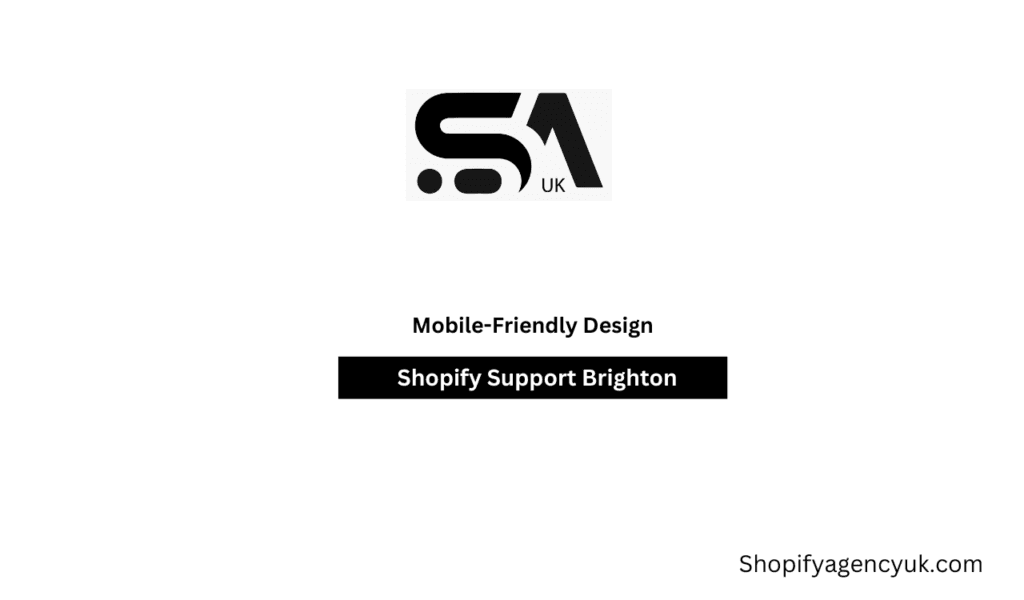Mobile-Friendly Design Tips: Boost Your Shopify Store
In today’s digital age, mobile commerce stands out to me as the most prominent trend. As a Shopify store owner, I am exposed to the fact that mobile-friendly design is not a mere option but a necessity for the growth of our business.
The higher the number of your customers using smartphones for browsing and purchasing products, the more I become aware of mobile users and the fact that your Shopify store, like Shopify Agency Leicester, can become more successful on mobile at a glance, thus converting more visitors to clients and resulting in a better Shopify store experience overall.
In this article, I will look at effective strategies and innovative tips that will help you build a mobile-friendly interface. This will not only increase the user experience but also make your site more compliant with the recent Google updates on SEO, making it more competitive in the eCommerce market.
Reasons Mobile-Friendly Design is one of the Important Parts of the Shopify Stores
I have noticed that more than half of the internet users are mobile-driven. Simply put, the web server or website is open and functional regardless of whether the user is mobile or tablet. My personal view is that the ones who use mobiles are looking for rapid loading, few clicks to navigate through, and very little time to search and buy, i.e., these are the factors that are directly responsible for the increase in conversion rates at mobile devices.
I have experienced situations where having a bad mobile site would cause very high bounce rates, abandoned carts, and loss of sales. In addition, I am aware that Google’s algorithm ranks websites optimized for mobile devices, so the stores that are not mobile-friendly will be deprived of the organic traffic that is so valuable for them.
The first priority, which I believe in, is making your Shopify store user-friendly. This is where users stumble on the site, and then your company becomes more successful. This is achievable through mobile optimization.
Mobile-Friendly Tips for Shopify Stores

To implement a mobile-friendly approach on your Shopify store, you must adhere to some fundamental design principles. The following are some tips to make mobile design simple and engaging and ultimately increase your conversion rates.
- Adopt a Responsive Shopify Theme
I am saying that getting a responsive theme is the foundation of a mobile-friendly design. Neither the player nor the bank cared about the promotion, so neither of them figures in the selection of the players nor the betting of the bank according to the following rules. Shopify has an extensive list of themes that can be adjusted for different screen sizes and devices.
It can be used for mobile and desktop versions without a separate mobile site. The site is guaranteed to have the same appearance and usability regardless of the screen resolution.
Steps for picking a responsive theme for mobile
Here are my recommendations for choosing a Shopify theme with the following features:
- Mobile-first design: Themes explicitly optimized for mobile users.
- Fast load times: Lightweight themes reduce the time your potential customers spend for your store to load.
- User-friendly navigation: Clear, understandable menus and secure and easy navigation buttons on mobile devices.
- Enhance the Speed of Your Mobile Site
I have discovered that the amount of time it takes for a page to load is the deciding factor in a user’s experience and rank on the search engine. In all my observations, mobile users expect nothing less than a fast-loading website, and any additional time incurred while loading a page may result in lost conversions.
I understand that download speed is an issue for slow websites, as it increases the bounce rate of buyers who are willing to leave your store before they even buy anything.
How to make the mobile page load faster
My first recommendation when you optimize your store is to compress your images with tools like Compressor or Shopify’s built-in image optimizer. Minimize the number of requests your browser makes to the server and only employ the scripts and plugins you need. Lazy loading: Load images and only the content that becomes visible as the page is scrolled, decreasing the initial load. Usage of accelerated mobile pages (AMP):
AMP is a web technology that aims to increase the speed of mobile web pages by consolidating them to contain only their most important content. After all, higher download speeds are beneficial for mobile phones as they consume less data, time, and power, hence providing a better user experience.
- Make Navigation Easier for Mobile Users
I have noticed that a congested and muddling navigation system may irascibly impact your mobile users, and bounce rates may become higher. At first, users expect to obtain the items they are looking for on a smaller screen on a smaller screen by clicking only on them. From my experience, simplifying the navigation system is crucial to obtaining a mobile-compatible web design.
Recommendation to Enhance the Mobile Navigation Generator
Mealtime in the school cafeteria is so much fun. I recently noted that the school is serving up some amazing dishes in the cafeteria. With the smaller screen, it is a necessity to provide direct access to the information they are looking for. To me, the best possible way to make your navigation simpler is to have a mobile-friendly design.
If your visitors’ first reaction to trying the mobile version of your website is to scroll up and down to be sure that they cover or access the page they are interested in, it means you need a better mobile user experience.
Mobile Conversion Optimized Your Shopify Store
Mobile shopping is a favorite for most customers, as devices have transformed from desktops to mobile, and it is by being on mobile that your Shopify store is required to be converted. In terms of mobile conversion, customers try to find those online shops that offer them more speed, convenience, and comfort. That’s why the more operational your store is, the more chances you have to increase your sales.
This is my opinion based on the fact that clients who shop online with mobile devices operate differently from those who buy [sic] through the desktop. Consequently, it would help to put more work into optimizing your store pages and checkout form to increase your mobile conversion rate.
Strategies for Improving Mobile Conversions

- A simplified checkout process has a few steps which can deter many potential customers. A mobile-friendly payment system that includes features like Apple Pay and Google Wallet may attract more users to your store.
- Give special attention to your page description. Be sure to enter only a few words summarizing your main points, which will appear on the screen on all mobile devices.
- Place a button that sticks with the “Add to cart” function. It will follow the users along the page as they scroll down, enabling them to add products to the cart without having to go back all the way up.
- Emphasize Mobile SEO for Higher Rankings
As I see it, since the point at which Google’s Mobile-first indexing scheme was set up, the mobile optimization of your Shopify store has been seen as an unavoidable precondition to guarantee its preferred placement in the search engine rankings.
This is evident when Google exclusively utilizes the mobile edition of your website before listing and indexing it. Hence, a mobile-responsive web portal is crucial for organic traffic growth.
Guidelines for SEO mobile version

- Mobile-friendly URLs are a must if you gain from the high-quality mobile ranking. Your URLs should be clean and readable on mobile devices to aid users in quickly understanding them.
- The meta tag must be optimized for the mobile version of your website. Keep the meta descriptions and titles brief and legible. By doing so, you will ensure that users can view them correctly on smaller screens. You can also give them access to information in case the pictures are not working, and they will continue reading substituted for the pictures.
- Ace Mobile UX with Touch-Friendly Design
The mobile user experience is, in reality, not only dependent on the appearance of your store but also on how easy it is for users to touch and interact with the screen. A mobile-designed page should consider that users will be touching, swiping, and pinching instead of using a computer mouse.
Strategies to Enhance the Touchscreen Experience
- Have large, solid, tap able buttons since people can get frustrated if Buttons and links need to be more significant to tap without zooming in or even pressing the wrong ones by mistake. [Ibid. Embarks? Rest the button surface in between tapping and swiping gestures for big buttons. Use Swipe or DRAG gestures for navigation features like moving within the image sliders or product galleries.
- Tie the space between links or buttons and ensure they are at a distance so that people will not accidentally click on one and you cannot find a link.
- Multi-Device Testing
It occurs to me that even if your Shopify site looks great on your smartphone, you should still check it with various devices to ensure everyone experiences the same impression. Mobile users have many devices with different screen sizes and browsers, so making a mobile device-compatible design that works with as many of these other options as feasible is the first thing you can do for them. The mobile test can be verified here:
Testing Adaptability on Mobile
- Mobile-Friendly Test by Google: This free tool from Google can give you a quick idea of whether your store is mobile-friendly.
- Browser Stack is a bothersome solution that lets you annoy your whole company by showing how your site looks on devices with various resolutions and browsers. Instead, try using Shopify’s preview feature, which gives you the choice of seeing your site on a tablet or a smartphone only.
FAQs
How does a mobile-friendly design contribute to Shopify stores?
A mobile-friendly design makes e-commerce smoother, letting customers shop for their favorite items on their mobile phones, tablets, or computers.
How can I improve mobile conversions on my Shopify store?
Here are a few recommendations: Cut down on the buying process steps. This will lead to more guest users who want to avoid signing up for an account but would rather have them quickly check out. As a rule of thumb, you ought to carry only the most necessary information if you want it to be viewed by the search engines.
What are the best practices for mobile SEO?
The essential mobile SEO guidelines could be Clean and readable mobile-friendly URLs. Meta tags should contain only the necessary information and be visible on smaller screens.
What Shopify theme should I use for a mobile-friendly design?
You had better select those themes that respond well to both controversies, especially those that are swift and give more practical details on the topic. They have widened the schema with some particular elements that represent authentic theme ratings in a more human-like way.
How can I test my Shopify store for mobile usability?
Use Google’s free tool to see how your store will perform on various devices and browsers. Your site can also try using your phone to test how the various browsers work with it.
Conclusion
Companies with a mobile-oriented e-commerce platform are more competitive than those without one. Nevertheless, many smartphone users continue to use the desktop version of websites because it seems more convenient because of the bigger screen and better display of information.
No matter how professional you are, your success in web design will be gauged by your level of excellence in customer satisfaction. Therefore, businesses should prioritize the UX/UI, which can be achieved through collaboration with a Shopify agency in Leicester. Mobile-first strategy agencies (Shopify) in Leicester can design and develop a responsive web experience that customers would receive well on desktop and mobile.
